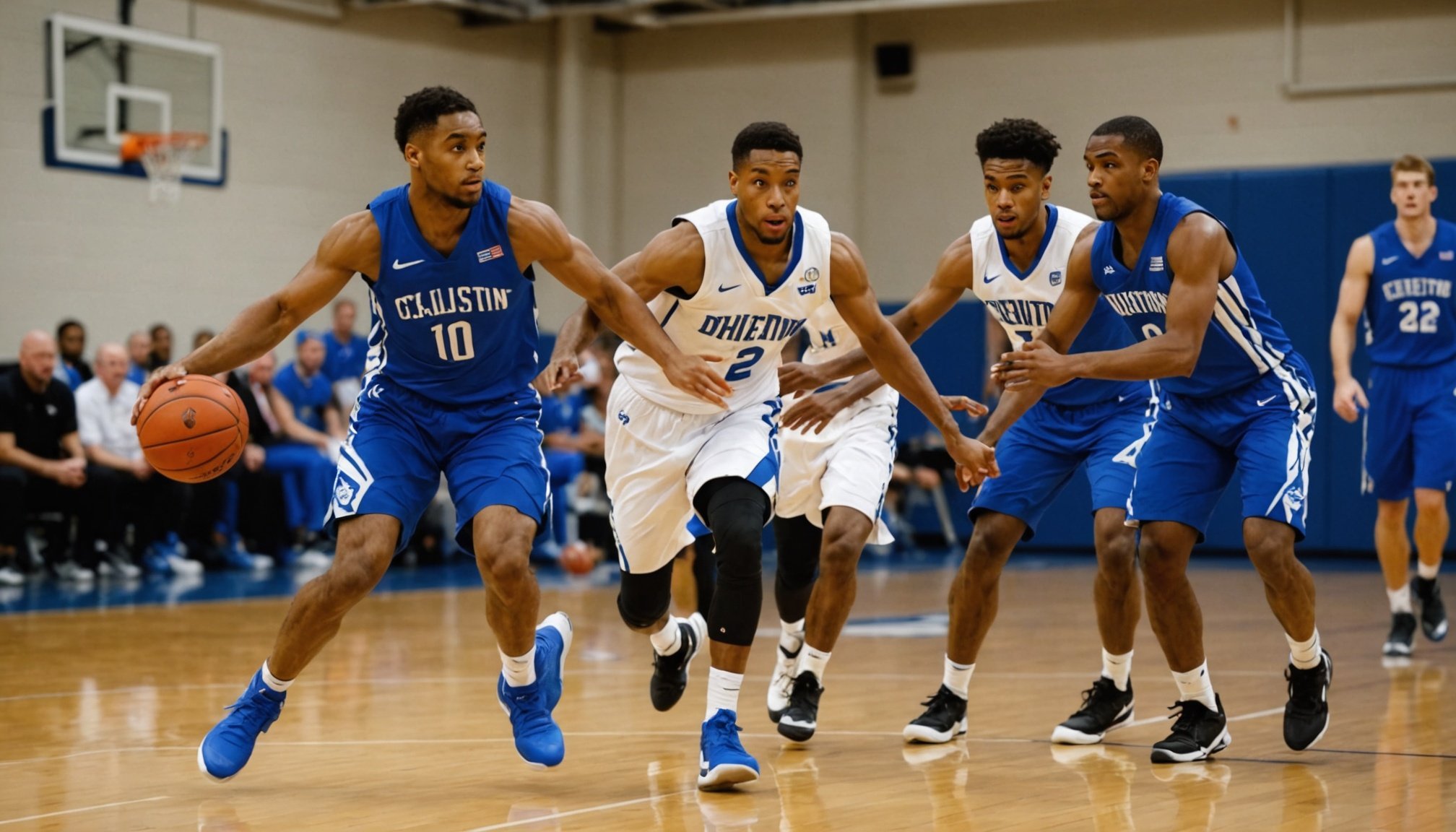Unlocking Agility: Creative Strategies for UK Basketball Teams to Enhance Players’ Lateral Movement
The Importance of Lateral Movement in Basketball
In the fast-paced world of basketball, lateral movement is a crucial aspect of a player’s skill set. It involves the ability to move quickly and efficiently from side to side, which is essential for both defensive and offensive play. For UK basketball teams, enhancing lateral movement can be the key to improving overall performance and gaining a competitive edge.
“Lateral movement is not just about speed; it’s about improving the coordination and reaction time necessary for basketball,” explains a coach from the London Lions, a prominent UK basketball team. “Players who regularly engage in agility exercises are better equipped to handle sudden changes in play, such as fast breaks or defensive switches.”
Have you seen this : Unlocking Defensive Excellence: Strategies for UK Basketball Players to Utilize Visualization Techniques
Effective Drills to Enhance Lateral Movement
To improve lateral movement, coaches and trainers need to incorporate specific drills into their training programs. Here are some of the most effective drills:
Shuttle Runs
Shuttle runs are a classic drill that involves sprinting back and forth between two points. This drill enhances speed and agility, which are crucial for quick directional changes on the court. Here’s how to set it up:
Also read : Top Strategies for UK Basketball Players to Enhance Game Day Concentration
- Setup: Mark two points about 10-15 meters apart.
- Execution: Players start at one point, sprint to the other, and then return to the starting point.
- Variation: To increase difficulty, add a change of direction halfway through the run.
Defensive Slides
Defensive slides are fundamental for improving defensive agility and footwork. Here’s how to execute this drill:
- Setup: Players line up in a defensive stance.
- Execution: On command, players slide laterally while maintaining a low defensive stance.
- Variation: Add a ball handler who tries to beat the defender, making the drill more game-like.
Ladder Drills
Using an agility ladder, players perform various footwork patterns that boost coordination and quickness. Here’s an example:
- Setup: Place an agility ladder on the ground.
- Execution: Players perform footwork patterns such as “Ickey Shuffle” or “Carioca Drill” through the ladder.
- Variation: Increase the speed and complexity of the patterns as players become more comfortable.
Incorporating Agility Training into Practice
Agility training is not a standalone activity but should be integrated into regular basketball practice. Here’s how to do it effectively:
Combining Drills with Game Situations
Agility drills should be combined with game-like situations to make them more relevant and engaging.
- Example: After a series of shuttle runs, players immediately transition into a defensive stance to practice defensive slides.
- Benefit: This approach helps players apply their agility skills in real-game scenarios.
Using Technology and Equipment
Technology and specialized equipment can enhance agility training. For instance:
- Agility Ladders: These are versatile tools that can be used for a variety of footwork drills.
- Cone Drills: Cones can be set up in various patterns to challenge players’ lateral quickness and precision.
- Box Jumps: These exercises focus on explosive movements and balance maintenance.
Case Studies: Successful Implementation in UK Teams
Several UK basketball teams have seen significant improvements by implementing targeted agility training programs.
The London Lions
The London Lions implemented a specialized agility training regimen focusing on lateral movement drills. Here’s what they did:
- Program: The program emphasized defensive slides and shuttle runs.
- Outcome: The team reported improved defensive capabilities and quicker reaction times on the court.
- Quote: “Our players’ ability to move laterally has been a game-changer. It’s allowed us to be more aggressive on defense and quicker on offense,” said a London Lions coach.
The Leicester Riders
The Leicester Riders adopted a comprehensive approach, integrating strength and conditioning exercises alongside agility drills.
- Program: The program included strength training, plyometric exercises, and specific agility drills.
- Outcome: The team noted a significant boost in players’ speed and coordination.
- Quote: “By combining strength and agility training, we’ve seen our players become more athletic and resilient. It’s made a huge difference in our performance,” said a Leicester Riders coach.
Best Practices for Coaches and Trainers
Coaches and trainers play a critical role in enhancing players’ lateral movement. Here are some best practices to follow:
Individualized Training Plans
Tailor drills to suit each player’s skill level, ensuring they are challenged appropriately while still able to succeed.
- Example: For less experienced players, start with simpler drills and gradually increase the difficulty as they improve.
- Benefit: This approach fosters both confidence and skill development.
Emphasis on Technique
Prioritize proper form and footwork in every drill. Accurate technique not only enhances performance but also reduces the risk of injury.
- Example: Ensure players maintain a low defensive stance during defensive slides and keep their knees bent during shuttle runs.
- Benefit: Proper technique improves overall athletic performance and safety.
Table: Comparison of Agility Drills
Here is a comparative table of some of the key agility drills, highlighting their benefits and variations:
| Drill | Setup | Execution | Benefits | Variations |
|---|---|---|---|---|
| Shuttle Runs | Mark two points 10-15 meters apart | Sprint back and forth between points | Enhances speed and agility | Add a change of direction halfway through the run |
| Defensive Slides | Players line up in a defensive stance | Slide laterally while maintaining a low defensive stance | Improves defensive agility and footwork | Add a ball handler to make the drill more game-like |
| Ladder Drills | Place an agility ladder on the ground | Perform footwork patterns through the ladder | Boosts coordination and quickness | Increase the speed and complexity of the patterns |
| Cone Drills | Set up cones in various patterns | Navigate through the cones | Challenges lateral quickness and precision | Use different cone patterns to vary the difficulty |
| Box Jumps | Place a box or bench on the ground | Jump onto the box and step back down | Focuses on explosive movements and balance maintenance | Vary the height of the box to increase the difficulty |
Practical Insights and Actionable Advice
For coaches and trainers looking to enhance their players’ lateral movement, here are some practical insights and actionable advice:
Start with Basics
Begin with fundamental drills like shuttle runs and defensive slides. These drills lay the foundation for more complex agility training.
Use Technology Wisely
Incorporate technology such as agility ladders and cones to add variety and challenge to your drills.
Focus on Technique
Ensure that players maintain proper form and technique during all drills. This not only improves performance but also reduces the risk of injury.
Make it Game-Like
Combine agility drills with game-like situations to make the training more relevant and engaging.
Enhancing lateral movement is a critical aspect of basketball training that can significantly improve a team’s performance. By incorporating effective drills, integrating agility training into practice, and following best practices, UK basketball teams can unlock their players’ full potential.
“Lateral movement is the backbone of basketball. It’s what separates good players from great ones,” said a coach from the Leicester Riders. “With the right training and dedication, any player can improve their agility and become a more formidable opponent on the court.”
By adopting these creative strategies, UK basketball teams can gain a competitive edge and achieve greater success in the sport. Whether you’re a coach, trainer, or player, understanding and implementing these agility training methods can be the key to unlocking your full potential in basketball.











